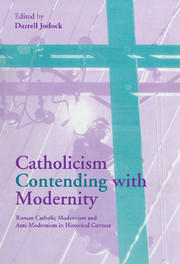 Catholicism Contending with Modernity
Catholicism Contending with Modernity Published online by Cambridge University Press: 30 October 2009
The questions a historian puts to his evidence determine the quality of the history he writes. Of equal importance to this quality is the level of analytic consciousness attained by the historian concerning the assumptions underlying his questions. To ask what the Roman Catholic Modernist crisis was and why it occurred when it did presupposes a number of assumptions about the ecclesial culture within which the crisis took place and about the individuals caught in the conflict. This last point about the individuals caught in the conflict is of special importance because the papal encyclical Pascendi dominici gregis not only created Modernism; it also created Modernists – as though dozens of individuals of varying ages and experiences and of a multitude of nationalities, with different degrees of religious development and levels of intellectual culture, thought with one mind and pursued one goal. The reality was rather different. No two so-called Modernists, in fact, shared more than a superficial identity; and one of them, at least, was simply unique, not only, of course, in who he was, but also in what he thought and did and why. The operative questions, then, in the task undertaken in these pages, will be: what can we know of Baron Friedrich von Hügel's personal religious development?; what was the ecclesial cultural context of this development?; and what was von Hügel's perception of and reaction to this context?
To save this book to your Kindle, first ensure [email protected] is added to your Approved Personal Document E-mail List under your Personal Document Settings on the Manage Your Content and Devices page of your Amazon account. Then enter the ‘name’ part of your Kindle email address below. Find out more about saving to your Kindle.
Note you can select to save to either the @free.kindle.com or @kindle.com variations. ‘@free.kindle.com’ emails are free but can only be saved to your device when it is connected to wi-fi. ‘@kindle.com’ emails can be delivered even when you are not connected to wi-fi, but note that service fees apply.
Find out more about the Kindle Personal Document Service.
To save content items to your account, please confirm that you agree to abide by our usage policies. If this is the first time you use this feature, you will be asked to authorise Cambridge Core to connect with your account. Find out more about saving content to Dropbox.
To save content items to your account, please confirm that you agree to abide by our usage policies. If this is the first time you use this feature, you will be asked to authorise Cambridge Core to connect with your account. Find out more about saving content to Google Drive.